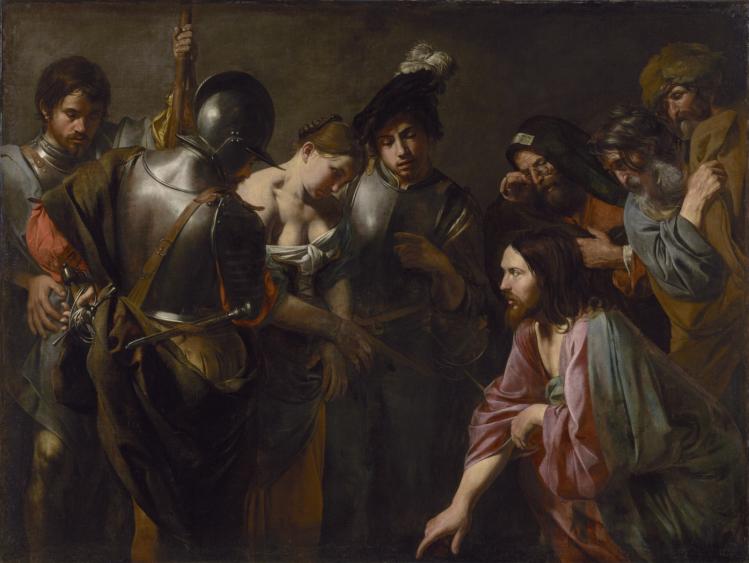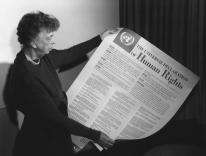
I suspect that no great argument was needed to make the Book of Revelation an entry in the “Lives of Great Religious Books” series. This last book in the biblical canon, with its prophetic voice and phantasmagoric visions, has had a long and often problematic history of reception that invites consideration of its remarkable longevity. Timothy Beal, a professor of religion at Case Western University, has earned a reputation for combining learning in biblical texts with an impressive grasp of contemporary cultural trends. Indeed, as the reader here learns, much of Beal’s own youth was immersed in present-day millenarian readings of this classic text (think Late Great Planet Earth or the Left Behind novels). This background would seem to make him an ideal guide to understanding the impact that Revelation could have. And in some respects, it does; the last hundred pages, for example, contain a mesmerizing account of the peculiar horror culture fostered by apocalyptic cultists.
Beal is also an effective interpreter of the (thoroughly non-apocalyptic) reading of Revelation in Augustine’s City of God, as well as of the medieval appropriations of the book’s imagery by Hildegard of Bingen and Joachim of Fiore. He shows how the book’s polyvalent symbolism can be read in quite distinct ways. Another of the pleasures of Beal’s treatment is his attention to art. In one instance, he shows how Cranach’s depiction of Revelation’s visions trumped Luther’s disapprobation of its text. In another, he recounts how the African-American folk artist James Hampton used bits and pieces of found objects to construct (in his Washington D.C. garage) a complete heavenly sanctuary based on the vision of God’s throne room in Revelation 4–5.
No one can dispute Beal’s evidence for the way Revelation’s imagery was used to demonize other religions or even large swaths of Christianity (for instance, equating the “Whore of Babylon” with the papacy). Such “othering” (to use Beal’s term) was, however unfortunate and ugly, scarcely owed entirely to that book, as the usage of patristic authors concerning Gentile religion makes clear. The tendency to emphasize the negative in the Book of Revelation, I think, is the main deficiency in this otherwise entertaining and informative treatment. This is especially true of the opening exposition, where Beal’s claims for the book’s violent misogyny lead him to some dubious reading of the actual text. He misses the opportunity to help readers understand more broadly the character of apocalyptic literature (a genre to which this writing belongs), and the ways that the Book of Revelation’s call to faithful witness against the powers of idolatry and corruption have strengthened countless believers, especially in times and places of persecution.
The Book of Revelation: A Biography
Timothy Beal
Princeton University Press
$26.95 | 288 pp.
It is refreshing to read a book that states a modest but well-defined goal and then proceeds to accomplish it through the application of clear thought. Such precision delights the reader particularly when the topic is one that, without the control of consistent logic, could easily grow unwieldy. Christian Smith is a professor of sociology at Notre Dame University, whose earlier books reveal him to be a philosopher intensely concerned with religion and morality. In this small book consisting of four relatively independent essays, he seeks to challenge what he considers the “overreach” of claims concerning human morality made by certain humanistic atheists (or atheistic humanists) by carefully examining the logical connections—or lack of connections—between the claims they make and the warrants for those claims.
Smith states that he wants neither to defend religion nor attack atheism, but instead seeks to advance the conversation by paying attention to arguments made by atheist authors. His interest, therefore, is not in the obvious facts that many atheists are (sometimes impressively) personally moral, nor in the (pretty convincing) arguments of evolutionary psychologists that a naturalistic explanation of the world provides the basis for a limited altruism that can extend to others in one’s family, tribe, or nation. His interest, rather, is in larger claims being made for a morality based on an atheistic premise.
His first chapter asks, “How good without God are atheists justified in being?” That is, do they have a basis, as some apologists hold, for a high standard of ethics without recourse to God? Smith concludes that intellectually honest atheists, lacking delusions about innate human goodness or the need for social control in the absence of religious conscience, “do not have good reasons justifying their strong, inclusive, universalistic humanism, which requires all people to adhere to high moral norms and to share their resources in an egalitarian fashion for the sake of equal opportunity and the promotion of human rights.” They fail to reckon, he says, with the weight of religious influence that still persists among people, and they have no real answer to the problem of the “sensible knave” who takes advantage of everyone else’s rule-keeping to break rules (as criminals do) for his own benefit.
The second essay is a fascinating variation on the first: What justifies aspirations for universal benevolence, egalitarianism, and equal rights among those who inhabit a “naturalistic” universe—that is, one that consists merely in material causes and effects without design or purpose? If humans are only accidentally and randomly selected, the logic of this view would seem to work in the opposite direction—a social Darwinism characterized by savage competition rather than sweet cooperation. To think otherwise, Smith suggests, is once more to borrow without acknowledgement from the traditions of transcendental warrants provided by religion, or to indulge in sloppy sentimentalism.
Smith’s third essay shifts from ethics to epistemology. “Why Scientists Playing Amateur Atheology Fail” makes the fairly obvious but often occluded point that the methods of science properly practiced do not (and cannot) be the basis for metaphysical or “atheological” declarations. His quote from Terry Eagleton summarizes nicely: “Imagine someone holding forth on biology whose only knowledge of the subject is The Book of British Birds, and you have a rough idea of what it feels like to read Richard Dawkins on theology.”
The last and most properly sociological of the essays asks whether humans are naturally religious. After a careful run-through of inadequate ways to ask or answer that question, Smith offers a highly qualified “yes,” in the sense that humans have natural capacities for religion that are real and resilient, but that can be either suppressed or encouraged by ideological and cultural influences. As I say, a careful and thoughtful book, with many notes at the end, but in a prose that is for the most part accessible to a non-specialist reader.
Atheist Overreach: What Atheism Can’t Deliver
Christian Smith
Oxford University Press
$19.95 | 168 pp.
Post–Vatican II Catholics who understand tradition as a living process, encompassing all the Church’s practices and above all its liturgy, might be surprised to learn that such an appreciation is not to be taken for granted. In truth, it is a hard-won perspective owed to such French Catholic theologians as Henri de Lubac, Yves Congar, and Jean Daniélou, all of whom were marginalized in the years before the council, but whose views animated the council documents on revelation and the Church. Catholics today are undoubtedly even less aware of the early-twentieth-century philosopher whom de Lubac himself named as the greatest influence on his own sense of tradition: Maurice Blondel (1861–1949).
Robert C. Koerpel teaches theology at the University of St. Thomas, and he seeks in his slender but densely written book to elevate this mostly ignored thinker to his proper place in the history of Catholic theology. Blondel was a philosopher by trade rather than a theologian, and this distinctive role allowed him to approach questions with fresh eyes. His earliest philosophical work (L’Action, originally published in 1893 and expanded to two volumes in 1936–37) served to lay the foundation for his later thinking about tradition within the Church. In contrast to the idealism of Kant and Hegel, which emphasized human cognition, and similar to his contemporaries Bergson and Marcel, who focused on the dynamism of embodied human existence, Blondel began his analysis with practice, specifically with the implications of human volition. It was in the gap between a person’s reach and his grasp when willing something that Blondel located the space for divine revelation. The same emphasis on practice, this time in the body of the Church, characterized his later contributions on tradition.
Koerpel works hard to show the intellectual context within which Blondel developed his understanding of tradition in works such as Histoire et Dogme (History and Dogma, 1904). On one side was the reductionistic historical-critical approach of Alfred Loisy, and on the other side was the equally reductionist approach of neo-scholasticism, which, following the lead of the First Vatican Council (1869–70), tended to define tradition propositionally in terms of dogma or magisterial pronouncements. Blondel advanced a more profoundly religious, even mystical, understanding of tradition, as the continuing presence of the incarnate Christ (through the Holy Spirit) within the practices—above all the celebration of the Eucharist—carried out by God’s people in the Church. It was a stunning insight that, by being positively appropriated by more renowned theologians like de Lubac, entered the consciousness of those of us fortunate enough to have inherited it.
Maurice Blondel: Transforming Catholic Tradition
Robert C. Koerpel
University of Notre Dame Press
$55 | 278 pp.
The story of Jesus and the woman caught in adultery is among the most vivid and memorable in the Gospel tradition. Jesus invites the one without sin to cast the first stone at her, and when her accusers withdraw, he releases the woman with the words, “Neither do I condemn you. Go your way, and from now on, do not sin again.” In English translations and in the critical texts of the New Testament on which the translations are based, the story appears in John 8:1–2. But it also appears in brackets of some sort, with an accompanying note warning that the story is absent from the earliest Greek manuscripts; that in some other manuscripts it is found after John 7:36, or after John 21:25, or even after Luke 21:38; and that there are many variations in wording even in texts that contain the story. Like the “longer ending” of Mark (16:9–19), the passage’s origin and authenticity are questioned by New Testament scholars, most of whom do not consider either story to be the work of the “original evangelist.” But if that is the case, how did they become part of canonical Scripture?
Jennifer Knust teaches at Boston College and Tommy Wasserman at Ansgar Teologiske Høgskole in Norway. Finding themselves both researching the passage on Jesus and the adulterous woman, they combined forces to produce this splendid and exhaustive examination of its textual history and reception by the Church. With scrupulous attention to every scrap of extant evidence, they probe the obvious questions: Was the passage added, was it omitted by accident, or was it suppressed for some ideological reason? They examine each possibility within the context of the actual practices of ancient scribes who worked on classical and biblical texts, showing how a strict fidelity to the version being copied was accompanied by the freedom to mark dubious passages with asterisks. The conclusion that the passage was not part of the evangelist’s narrative, however, is only the first step. How did it get into that narrative?
The authors trace the signs of a story about Jesus and a woman caught in sin that can be detected as early as the second or third centuries—at a time when our earliest papyri evidence was being produced. The story was around, in other words, for a long time. Then they show how the story was incorporated into its respective locations in Greek and Latin manuscripts of the New Testament. In the West, the acceptance of the passage (“found in many manuscripts”) by Jerome in his Vulgate translation sealed the deal.
In the East, the liturgical reading of the passage meant its inclusion in lectionaries, which turn out to be invaluable sources for the text critic. The passage, in brief, was a witness to the character of Jesus that was regarded as evangelical, even if it had not been penned by an evangelist. In a very real way, this study confirms what Maurice Blondel argued about tradition (see the previous review): the practices of the Church form and transmit tradition, and sometimes the shape of Scripture itself.
Although massively learned and minutely argued, this book on an apparently arcane and insignificant issue makes a major contribution to our understanding of early Church history as well as contemporary debates about the relation of Scripture to tradition. It also makes a major statement concerning text-criticism of the New Testament as a whole: the quest for the “original text” has some merit, but the far more fascinating topic is the history of textual reception—how Scripture was actually read in diverse communities.
To Cast the First Stone: The Transmission of a Gospel Story
Jennifer Knust and Tommy Wasserman
Princeton University Press
$45 | 464 pp.
Please email comments to [email protected] and join the conversation on our Facebook page.
Previous Story
COVID Fatigue
Next Story
Theological Resistance


